Du Chinese

Summary
Du Chinese is one of the best resources for learning Chinese. This app will help you to improve your Chinese reading skills as well as listening comprehension. There are articles across six different levels – from Beginner to Master. The design of this app is absurdly good, making it exceptionally easy to use. The biggest weakness is that new content isn’t added frequently enough.
Amazingly high-quality with lots of useful features.
New articles are added fairly slowly, but they age well.
You can read some articles for free.
I Like
- The design is superb, and it’s loaded with useful features. I love how it uses highlighted words to synchronize the audio playback to the text.
- The articles cover interesting content and remain relevant for months after release.
- Articles can be downloaded for offline use.
I Don’t Like
- Content isn’t added frequently enough. For most levels, a new article is only added about once per week.
- Content is added even less frequently for Advanced and Master levels.
Price
A subscription to Du Chinese costs $14.99/month. A six-month plan costs $89.99. A one-year subscription would cost $179.99/month. There is also a limited selection of lessons available for free.
The Du Chinese app is quite possibly the best-designed app out there for learning Chinese. I don’t know if it’s necessarily the best Chinese-learning app overall, but the developers really did an outstanding job.
In this review, I’ll take a closer look at Du Chinese and help you decide whether or not it’s worth the subscription cost.
New Updates (March 2024)
Recently, I had the chance to check out Du Chinese’s new updates, and I’m pleased to share a more practical take on the enhancements. As someone who regularly uses the platform, I appreciate the ongoing efforts to improve user experience, and the new updates bring some notable benefits to the table.
Progress Charts: The new progress charts have become my go-to tool for tracking my reading journey. They show my reading progress over the years including lessons read, words read, and characters read. After every lesson that I read, there is a graph that shows my word learning progress, how many new words I encountered, and how many words I “learned,” which means I read it at least ten times. It’s nice to be able to see your progress and it definitely gives me a sense of accomplishment to see the number go up!
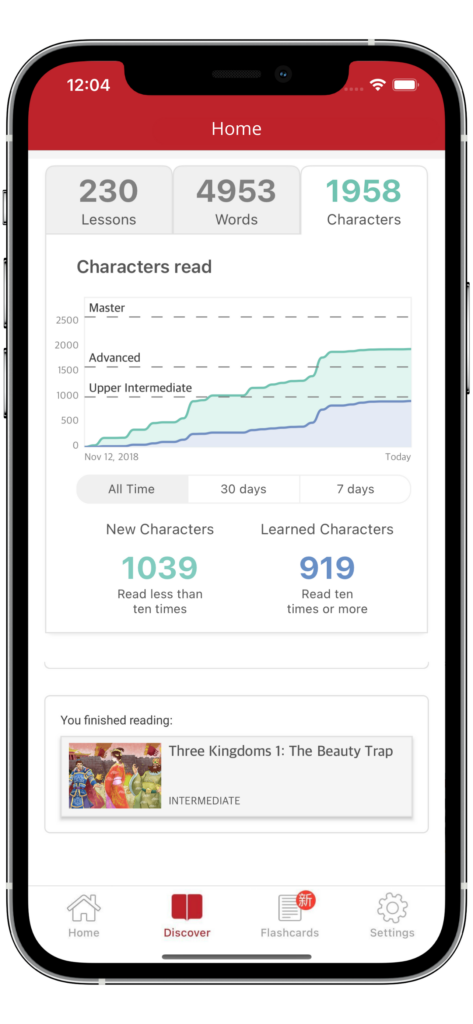
New Flashcard Design: The updated flashcards caught my attention immediately. The cleaner layouts make the learning process more enjoyable. There is now a personalized space that categorizes your saved words based on your level of familiarity with them in the spaced repetition system (SRS). The categories include:
- Strong: Words you remember easily
- Weak: Words you still need to review
- Not Studied: New Words that are waiting in line for the SRS system to introduce to you during your study
- All Saved Words: an overview of your entire vocabulary bank.
Within each category, you are able to bulk select words to easily manage your word lists. This breakdown helps you track your progress and focus on the words that need more attention. There is even a section for you to just focus on “forgotten words” so you can spend more time on words you just can’t seem to memorize.
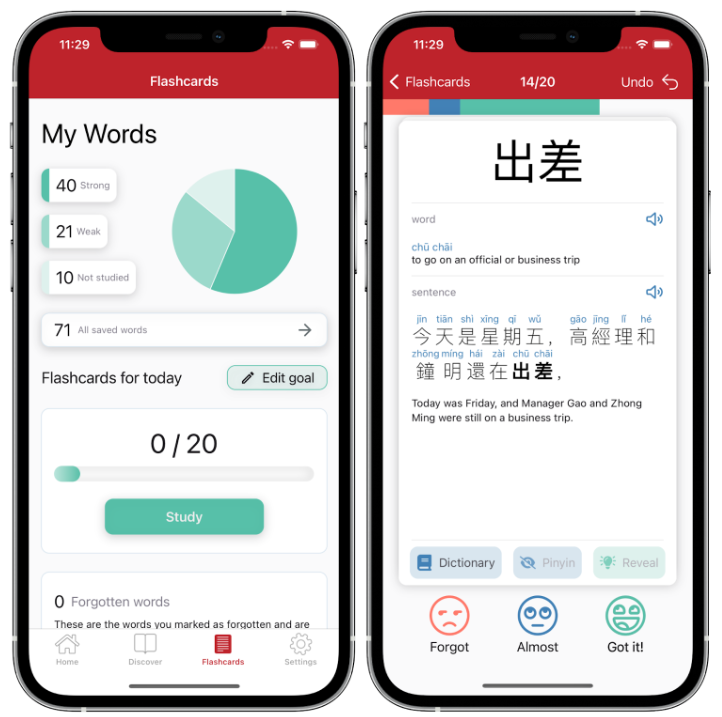
Detailed Grammar Explanations: The most exciting update might be the new grammar explanations. It has really been a game-changer for me. Instead of scrambling to find explanations online, I can now find grammar point explanations with examples, common mistakes and usage notes within the app and in context. You can turn on grammar highlights to see grammar points at the content’s level and above in your reading settings and access the grammar points from the pop up menu.
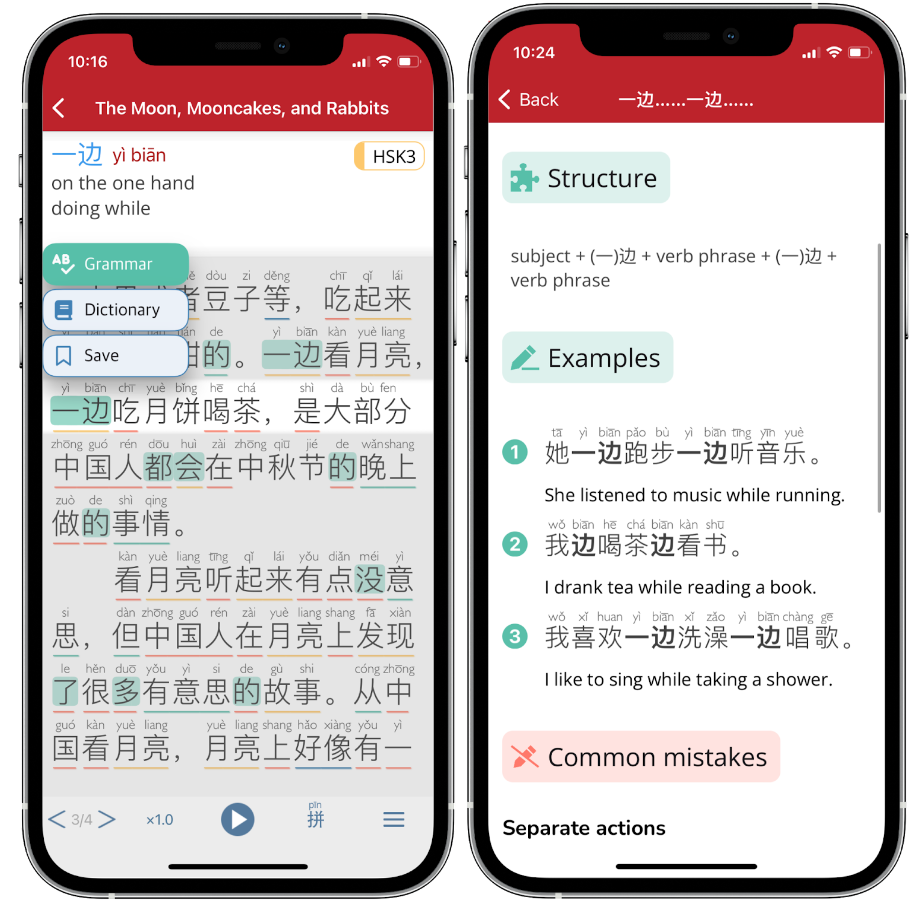
Audiobook Mode: While free and paid users can listen to the audio of any reading, Du Chinese also has an Audiobook Mode for paid subscribers. This feature is really nice because you can listen to full courses and stories while on-the-go. It is like turning on a podcast to study Chinese while driving or going on a walk.
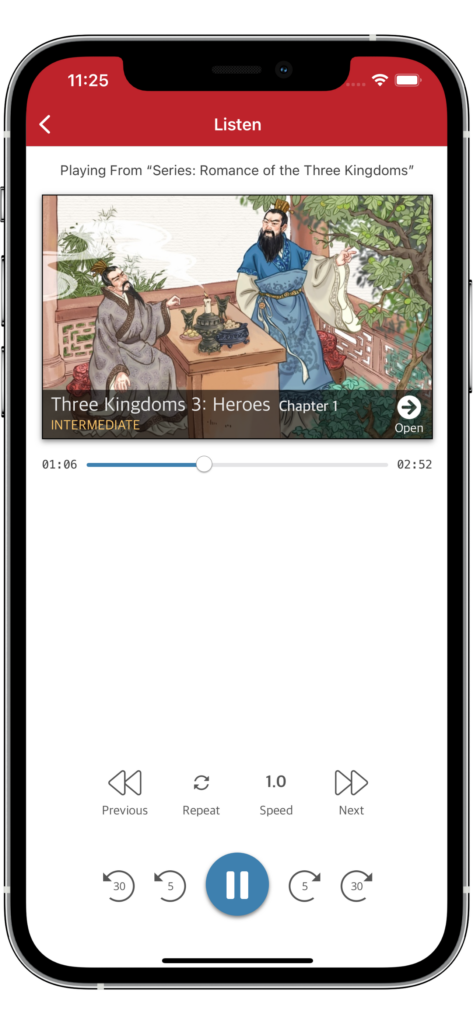
Impressive Design
First off, I just have to reiterate how smooth and well-made this app is. It’s about as sexy as a Chinese learning app can be. It packs all of the features I could want into a clean interface that can be customized to fit my preferences.
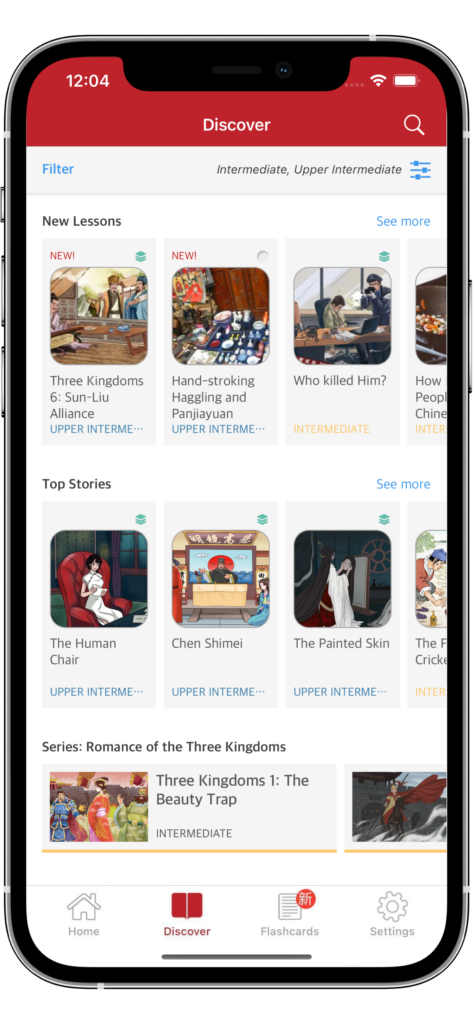
Across the top of the screen of any reading is the English translation of the highlighted sentence. I love that you can tap it to show or hide the translation. If it always showed the English, I could see myself using it as a crutch too often.
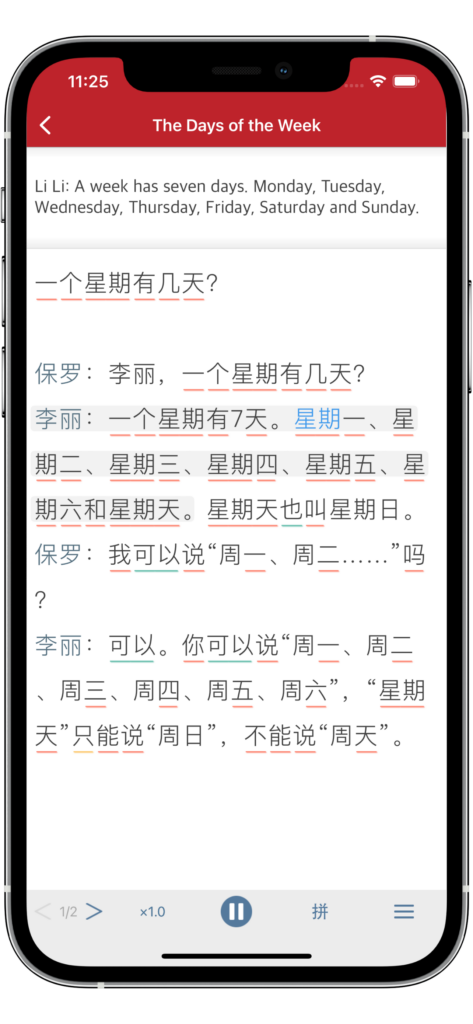
Without the translation, however, I wouldn’t always be sure I understood the sentence correctly. I like hiding the English and then using it to check comprehension later if I’m confused about something.
Another awesome feature is that you can show pinyin over the characters. Again, this isn’t something I like using too often — my brain will take the path of least resistance and ignore the characters. But they even have a setting called “Difficult words only”, which will automatically hide pinyin for words below the level of the story that you are reading. However, much like the English translations, it’s nice to have and can be very helpful.
Additionally, clicking the HSK button will underline words in different colors corresponding to their HSK level. It’s not exceptionally useful but pretty cool nonetheless and doesn’t get in the way.
By clicking the play button, you’ll hear the text read by a native speaker at a slightly slower than natural pace. The speed does seem to pick up a bit as you move into the Upper-Intermediate level and beyond.
There is also the option to speed up the audio to 1.5x or slow it down to .5x. While it sounds pretty weird, it’s another useful feature that not many competitors offer.
As the audio plays, the corresponding section of the text is highlighted in blue; this is perfectly synchronized to the audio.
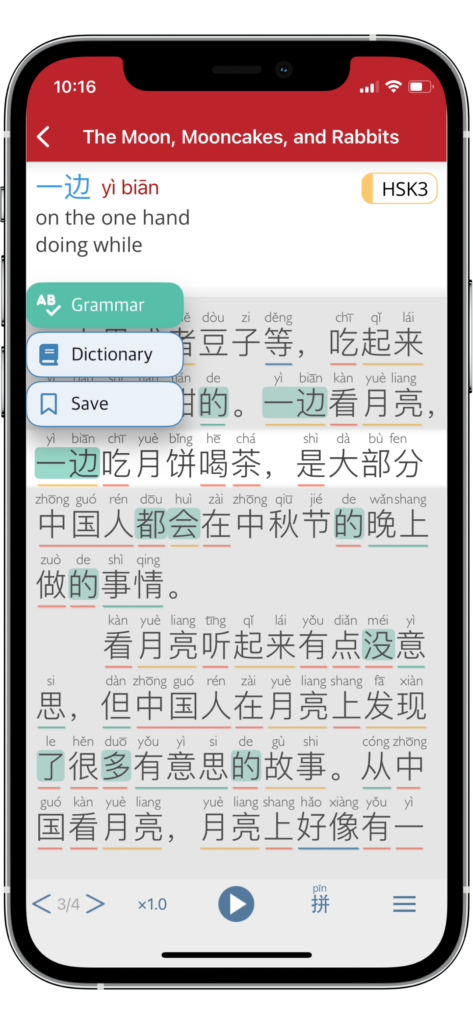
When you click on a word, the audio will pause and you’ll see the translation, pinyin, HSK level and have the option to save the word for later practice. The design here is nearly perfect.
Readings
They have articles, stories and courses across a variety of topics to choose from. The articles are quite short. At the intermediate level, there’s generally one to two minutes of audio. More advanced levels have longer readings and those at lower levels are shorter.
The topics are actually pretty interesting to listen to. They often focus on different aspects of Chinese culture, current events and life, meaning you’ll learn about more than just the Chinese language with Du Chinese.
They have a decent-sized library comprised of six levels: Newbie, Elementary, Intermediate, Upper-Intermediate, Advanced, and Master.
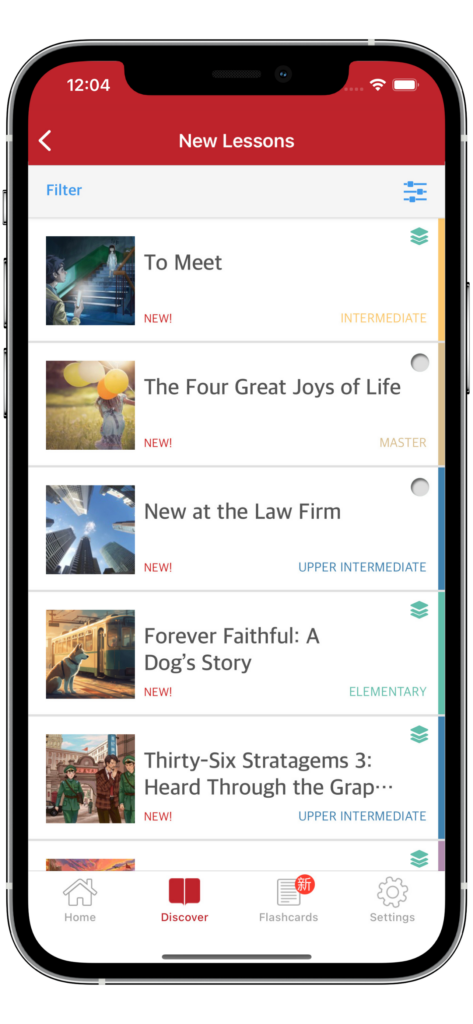
Since our initial review of Du Chinese in 2017, the library has grown substantially. They now have over 3,000 readings across Newbie to Master. There aren’t quite as many lessons at the Master level, but these tend to be longer and there are still quite a few of them.
Readings are also divided into several different categories. These include Short Stories, Everyday Life, Funny Story, Work, and Language, among others. You’ll also find some multi-part stories, which is a fantastic addition to the reading catalog.

New lessons are typically added at a rate of five or six per week, but this includes all levels. If you want to stick to just one level you’ll only get four or five new lessons per month. And remember, these lessons are quite short. It would be pretty easy to work through several of them in a single afternoon.
Fortunately, the lessons age well, meaning that even things posted ten months ago will still make interesting and relevant study material. Their backlog is now big enough that you won’t have to worry about exhausting their material in a short period of time.
There’s also nothing wrong with jumping up or down a level for a nice challenge or easier practice. It is also worth it to browse through the different stories and courses since they typically have the first few chapters available to read for free.
Flashcards
You can practice the words you saved while reading through the lessons with SRS flashcards.
Unsurprisingly, this feature is also well done. You’ll be shown a character and can tap to show the meaning and pinyin or the sentence in which you came across the word. With their new design, you have the flexibility to show the pinyin before revealing the translations, allowing you to test your knowledge step by step.
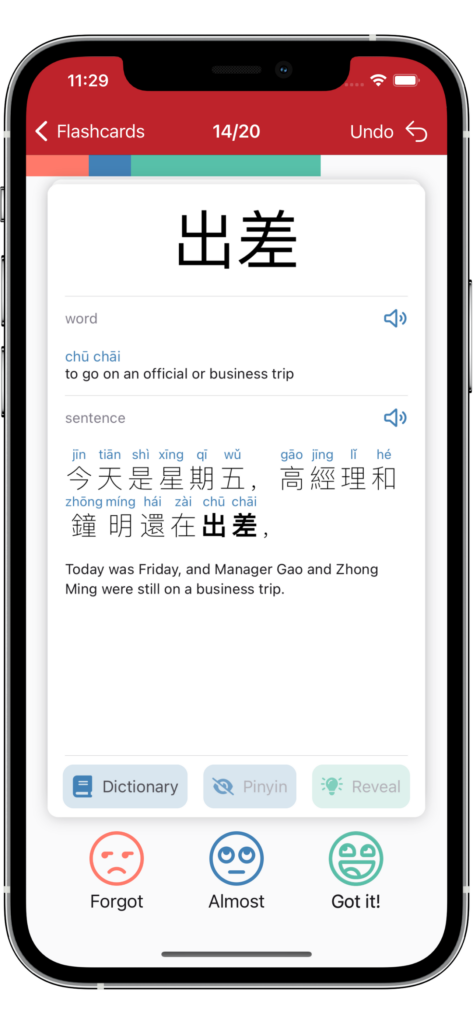
Pretty cool, but it gets better still. If you click the word info button you’ll find more information.
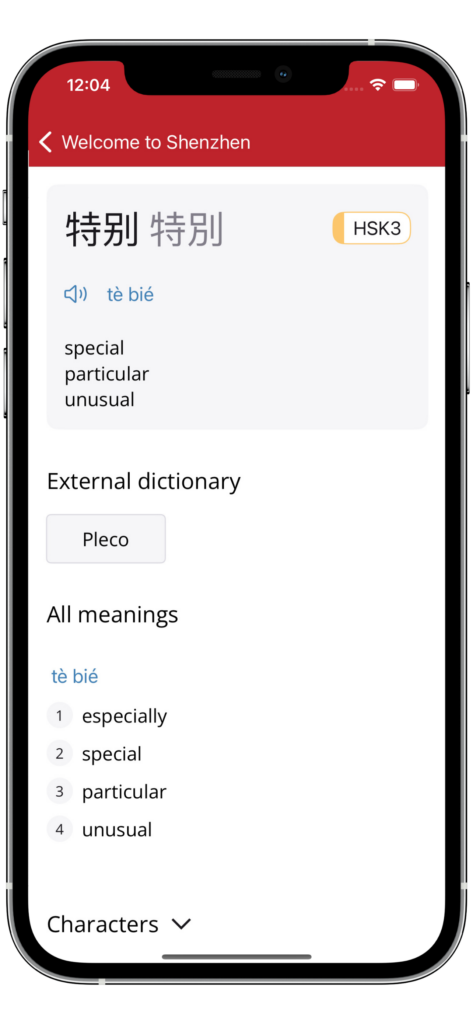
Here you can find additional definitions and the meanings of the individual characters. This also includes links to export the word to Pleco.
Pricing
The basic version of Du Chinese is available for free and includes a limited selection of lessons. This is great if you want to try the resource out before buying to see if it’s for you.

Subscriptions to Du Chinese are available for $14.99 a month, $79.99 every six months, or $119.99 for a year.
Final Thoughts
Du Chinese is an exceptionally well-made product. Its biggest weakness is that there just isn’t that much new content being added. However, since the topics they write about tend to be evergreen, this isn’t a major problem. An article written one year ago will usually be just as relevant as one written this week.
If a lack of new content being added is a deal-breaker for you, you should consider The Chairman’s Bao. However, I’d still recommend trying Du Chinese. They have free lessons and you can decide for yourself if it’s worth the subscription cost.
If you use the coupon code “alr10dc” you’ll get an additional 10% off your subscription.


As a visual learner with bad hearing, Du Chinese is like a visual podcast for learning to speak and listen, even for someone not learning to read. Listening to podcasts takes a lot longer and I can’t clearly hear every consonant and tone well enough to be confident in learning the word aurally without a visual reference. I tried the free lessons (Newbie/Elementary) and Du Chinese worked great as a podcast alternative to listen and speak Chinese at my own pace. If I already know a word or sentence, I am not wasting time listening through a chatty podcast to get to the new bits, so it’s much more efficient.
First listen to the text at full speed. Then again at half speed to catch missing words. Then read along with it, repeat each line out loud, while going through unknown words or sentence constructions and add them to the flashcards. Then read the English translation line by line and try to say them in Chinese without looking at the text. Too bad they are slow to update because in this way it seems to be a more efficient learning than any of the other podcasts I’ve tried. It’s super useful and I’m not even trying to learn to read at this point!
When you open a lesson and click “study now” it automatically downloads. You can see the download progress at the bottom-middle part of the screen. The play button replaces it once the lesson is downloaded. Then you can read and listen to it offline.
You mentioned that Du Chinese Articles can be downloaded and read and listened offline. How is it done?